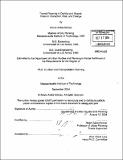| dc.contributor.advisor | Ralph Gakenheimer. | en_US |
| dc.contributor.author | Ardila Gómez, Arturo | en_US |
| dc.contributor.other | Massachusetts Institute of Technology. Dept. of Urban Studies and Planning. | en_US |
| dc.date.accessioned | 2008-02-28T16:02:53Z | |
| dc.date.available | 2008-02-28T16:02:53Z | |
| dc.date.issued | 2004 | en_US |
| dc.identifier.uri | http://dspace.mit.edu/handle/1721.1/28791 | en_US |
| dc.identifier.uri | http://hdl.handle.net/1721.1/28791 | |
| dc.description | Thesis (Ph. D.)--Massachusetts Institute of Technology, Dept. of Urban Studies and Planning, 2004. | en_US |
| dc.description | "September 2004." | en_US |
| dc.description | Includes bibliographical references (p. 425-454). | en_US |
| dc.description.abstract | What is the role of planners in the planning process for new transit modes? By documenting transit-planning processes in Curitiba and Bogota from 1955-95 and 1986-2001, respectively, this work demonstrates that in both cities planners had important roles in system design, the inventive adaptation of new technologies to local conditions, the integration of newly proposed systems with existing service and, above all, mediation between political leadership and strong vested interests. Both cities put planners' roles in special context, however. First, the mayors had a firm appreciation of planning services and understood that planners needed to interact with stakeholders and politicians. Second, the mayors were strong leaders who offered planners a benchmark from which to understand the implications of stakeholders' demands. Third, these cases were framed by new technologies such as Bus Rapid Transit, which competed against rail alternatives. Fourth, because of the novelty of BRT planners had difficulty producing credible forecasts. This uncertainty forced planners to interact more with stakeholders and politicians to build credibility. Fifth, BRT offered the advantage of being highly flexible, particularly when compared to rail proposals. This flexibility allowed planners to adjust the plans in response to the feedback produced by the interaction with stakeholders and politicians. Adjusting the plans often forced planners to innovate. Within this context, planners' main role was to interact with politicians and stakeholders. The interaction was above all a source of feedback for all parties involved. Planners used this feedback, first, to mediate between politicians and stakeholders by reducing power differentials. If either actor | en_US |
| dc.description.abstract | (cont.) were too powerful the planning process could not advance. Second, planners developed incremental adaptations to the original plan in light of the political reality unveiled by the interaction. The gradual adjustments to the original plan lowered risk for all parties. The adaptations and the reduced risk helped assemble coalitions of support. Planning teams with high levels of political capacity were able to interact with politicians and stakeholders. Planning teams also needed a high level of technical capacity to prevent stakeholders from capturing/co-opting the planning team. | en_US |
| dc.description.statementofresponsibility | by Arturo Ardila-Gómez. | en_US |
| dc.format.extent | 454 p. | en_US |
| dc.language.iso | eng | en_US |
| dc.publisher | Massachusetts Institute of Technology | en_US |
| dc.rights | M.I.T. theses are protected by copyright. They may be viewed from this source for any purpose, but reproduction or distribution in any format is prohibited without written permission. See provided URL for inquiries about permission. | en_US |
| dc.rights.uri | http://dspace.mit.edu/handle/1721.1/28791 | en_US |
| dc.rights.uri | http://dspace.mit.edu/handle/1721.1/7582 | |
| dc.subject | Urban Studies and Planning. | en_US |
| dc.title | Transit planning in Curitiba and Bogotá : roles in interaction, risk, and change | en_US |
| dc.type | Thesis | en_US |
| dc.description.degree | Ph.D. | en_US |
| dc.contributor.department | Massachusetts Institute of Technology. Department of Urban Studies and Planning | |
| dc.identifier.oclc | 60248864 | en_US |
